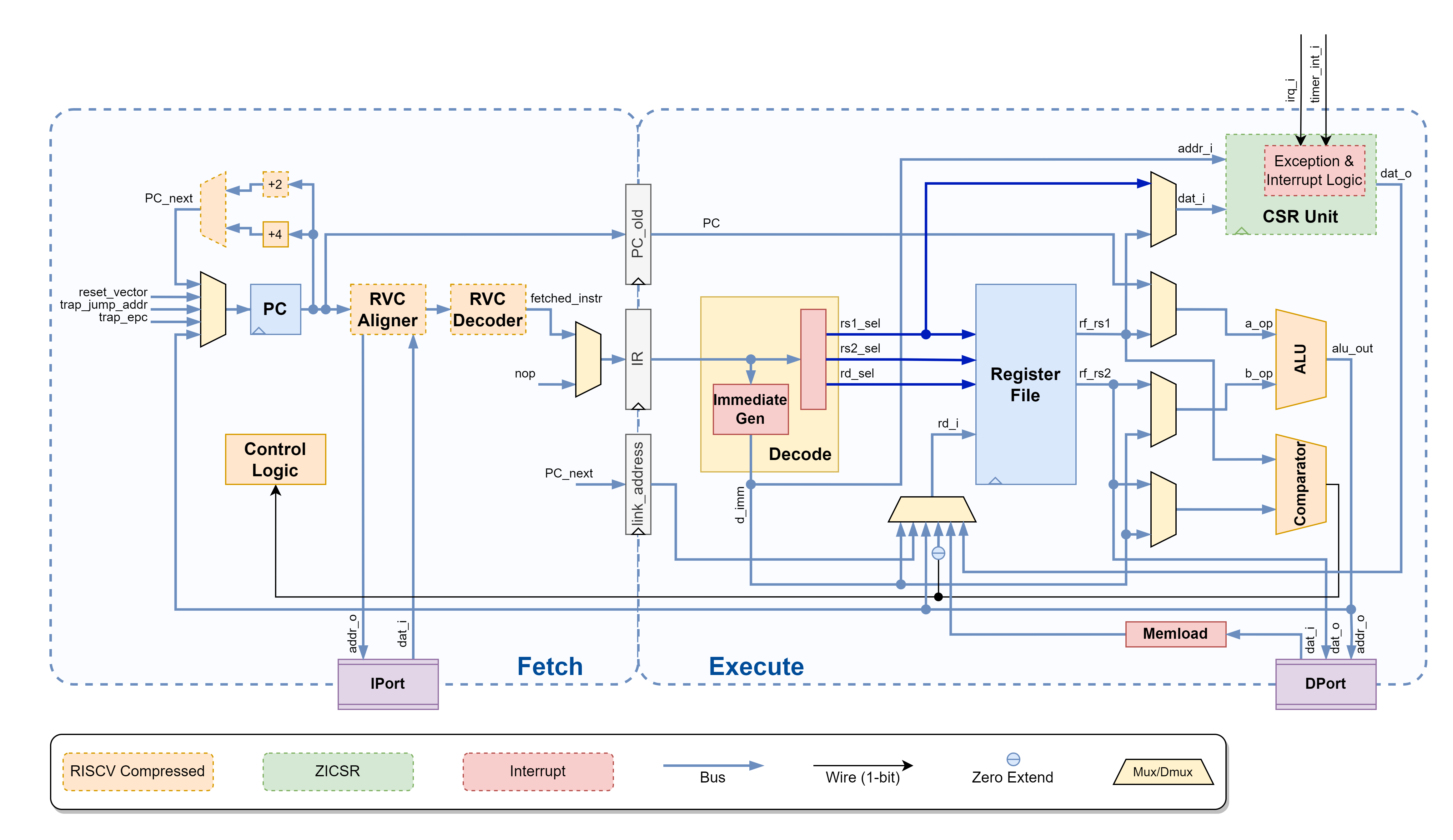RISC-V Atom CPU
Atom is an open-source 32-bit soft-core processor written in Verilog. It is an embedded class processor architecture that implements the open-source RISC-V instruction set architecture (RV32IC), as described in the RISC-V unprivileged spec. Atom contains a two stage pipeline inspired from arm cortex m0+.
The following diagram showcases the architecture of RISC-V Atom core.

Atom Pipeline Stages
The pipeline is divided into two stages. These are explained below.
Stage-1: Fetch
Fetch unit is responsible for fetching instructions from instruction memory through the IPort. It uses a 32-bit Program Counter (PC) to keep track of the address of the instruction being fetched. After the instruction is successfully fetched, Program counter is incremented by either 4 or 2 (in case of compressed instruction). Fetch stage also includes pipeline control logic which controls pipeline stalls and flushes. If compressed extension in enables, Fetch stage includes RISC-V Compressed Aligner which aligns all the memory requests to 4 byte boundary. It also includes RISC-V Compressed instruction decoder, which decodes 16-bit compressed instructions to their 32-bit equivalents.
Stage-2: Decode, Execute & Write-back
In this stage, the instruction from Instruction Register (IR) is decoded and executed. First, the decode unit decodes the instruction and sets all the control signals in order to configure the data-path to execute the instruction. Parallelly, operand registers are fetched and 32-bit immediate value is generated. Next, ALU/Comparator does the necessary computation/comparison and the results are written back to register file. In case current instruction invokes a memory request, stage-2 is stalled until response is received. Memload module is used extract the correct data from the received memory response. If CSR extension is enabled, CSR Unit is included in this stage. CSR Unit provides Control and status registers which perform various special functions. SR Unit also includes exceptions and interrupt handling logic if Exceptions and interrupts are enabled. Branch calculation also happens in this stage and if branch is taken, a signal is sent to the pipeline control logic to flush the pipeline.
Atom Interface
Atom module is defined in the file RVATOM/rtl/core/atomRV.v. It has has two independent ports (IPort & DPort)
which it uses to access memory. Both the ports use a generic ready-valid handshaking protocol to transfer data. We also
provide wrappers to the core to convert the generic handshaking protocol to standard bus protocols such as Wishbone.
These wrappers are specified in the following files.
Wishbone-B4 Wrapper with separate instruction and data port:
RVATOM/rtl/core/atomRV_wb.v
Atom Configuration operations
Macro |
Function |
|---|---|
|
Enables support for RISC-V Compressed Extension |
|
Enables Control and Status Registers (CSRs) |
|
Enables support for RISC-V interrupts and exceptions |
|
Enable DPI Logger |
RISC-V Atom RTL
RISC-V Atom is written in Verilog. The RTL specification for Atom is divided into 3 categories, core, uncore and soc,
all of which reside in the rtl directory.
Core Directory
The rtl/core subdirectory contains the the core components of the CPU such as register file, ALU, decode unit etc.
It also contains Verilog header files like Defs.vh and Utils.vh. Defs.vh contain various signal enumerations
and other parameters internal to the processor. Utils.vh defines some useful utility macros.
Uncore Directory
The rtl/uncore subdirectory contains the SoC peripheral components such as UART, GPIO, memories, etc. It also
contains the wishbone wrappers of some non-wishbone components. SoC implementations of the Atom processor usually
instantiate these hardware modules in their implementations.
SoC directory
The top level Verilog modules for SoCs (such as AtomBones & HydrogenSoC) are present in the rtl/soc directory in the
corresponding subdirectories. Each of these top level modules are configured by their respective configuration headers
(<name>_Config.vh file). These configuration headers contain the macros used in the top-module definitions to control the
generation of SoC, various sub-components and their parameters.
RTL Features
DPI Logger
DPI Logger is a System Verilog DPI based logging mechanism provided with the RTL. It can be used to dump useful run-time
debug information such as PC values, Jump addresses, Loads and Stores, etc. into a log file. This module is present in
the rtl/dpi subdirectory.
To enable DPI Logger simply define DPI_LOGGER macro in the top-module or in the CLI as -DDPI_LOGGER. This will
trigger the inclusion of the rtl/dpi/util_dpi.vh header in rtl/core/Utils.vh. User is free include the
rtl/core/Utils.vh header file in any Verilog file that needs to be debugged.
To log information, user first needs to call the dpi_trace_start() function somewhere in the rtl as following.
initial begin
dpi_trace_start();
end
Then the dpi_trace() function can be used to dump information. Its syntax is exactly same as the Verilog $display
system function. Example of logging the jumps during code execution is provided in the AtomRV.v file and is also
shown below.
`ifdef DPI_LOGGER
initial begin
dpi_logger_start(); // begin logging
end
`endif
`ifdef LOG_RVATOM_JUMP
always @(posedge clk_i) begin
if(jump_decision) // on some trigger condition
dpi_logger("Jump address=0x%x\n", {alu_out[31:1], 1'b0}); // dump information
end
`endif
For logging the Jumps, user must also define the LOG_ATOMRV_JUMP macro in a similar way. This will generate a run.log
file in the current directory containing all the dumped information.